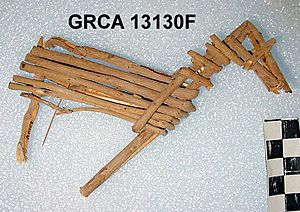Split-twig figurine facts for kids
Imagine finding a tiny animal made from a twig! These cool objects are called split-twig figurines. People made them a very long time ago, between 2,000 and 4,000 years ago. That's during a time called the Archaic period in North America.
These figurines are found in the western states of Arizona, Utah, Nevada, and California. They are made from flexible wood, like willow branches. The twigs are split down the middle and then carefully wrapped. Most of them look like animals. Scientists think these figurines had different uses for the people who made them.
What Are They Like?
Scientists have found two main styles of split-twig figurines. Each style might have been used for different things. Some were possibly for religious ceremonies or rituals, like totems. Others might have been toys for children.
A totem is often an animal or plant that a group of people uses to identify themselves. It can also be a symbol of their connection to that animal or plant. In this case, the figurines probably represented animals that lived in the areas where they were found.
Since they were first found in the 1930s, over 400 of these figurines have been discovered. They come from more than 30 different places across the four western states. Scientists use a method called radiocarbon dating to figure out how old they are. This shows that people made split-twig figurines for about 1,700 years!
Two Main Styles
The two main styles are called the Grand Canyon style and the Green River style. The difference is in how the twigs are wrapped. Sometimes, other things like small plant pieces or even tiny projectile points (like arrowheads) were put inside the figurines.
- Grand Canyon Style: These figurines have horizontal (side-to-side) wraps on the body. They have vertical (up-and-down) wraps around the neck. The unsplit end of the twig forms the body's core. A split in the twig at the neck or chest is typical for this style.
- Green River Style: These figurines have horizontal wraps on the body first. Then, vertical wraps are placed over them. The unsplit end of the twig forms the back legs. A split in the twig at the back end of the figurine is common for this style.
Where Were They Found?
Split-twig figurines have been found in several different states. Each area often has a specific style of figurine.
Arizona
Most of the split-twig figurines found in Arizona are of the Grand Canyon style. Scientists believe these figurines were important for the hunter-gatherer groups who lived there long ago. They might have been used in special ceremonies or as totems.
Many people think these figurines represented animals like Bighorn sheep or even an extinct type of mountain goat. It's possible they helped groups identify themselves. They might also have played a role in rituals to help hunters find these animals. These figurines were not found with everyday items, which suggests they had a special, non-daily use.
Utah
Split-twig figurines were also found in Utah in the 1930s. However, their discovery wasn't widely known until the 1960s. More were found in the 1990s. The figurines found here are called the Green River style, likely named after the Green River.
Unlike those in Arizona, the figurines in Utah were found with things people used every day. This included food scraps and other items. This suggests they might have been used in a more common, household setting.
California
Figurines found in California also belong to the Green River style. They were often found in places that seemed like homes. However, some scientists think they might still have been used for rituals. This is because of other special objects found with them. These figurines are also thought to represent bighorn sheep, which lived in the area.


